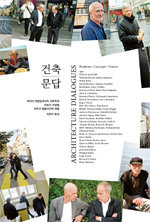‘Architecture Dialogues’ might provide comfort to architects
‘Architecture Dialogues’ might provide comfort to architects
Posted April. 15, 2020 07:52,
Updated April. 15, 2020 08:04


There are so many compilation books that are merely a collection of speeches and phrases from lectures or conversations. They are the main reason that makes people doubt the usefulness of similar type of books. Then how about a recently published book, “Architecture Dialogues,” which is a collection of lectures, discussions, and interviews from the Department of Architecture at the ETH Zurich? To put it simply, the book will be a great present to young students, who are studying architecture or wish to work in the building industry.
“In the field of architecture, the direction of thoughts is established through dialogues within the industry. This book focuses on the potential relationship between the thoughts and behavior (of architects), not their style,” wrote Marc Angelil, head of the Architecture Department at ETH Zurich, in the preface. Nine architecture columnists strictly followed the guideline as the authors of this book.
Thirty teams of Swiss architects, ranging from 87-year-old Luigi Snozzi to 45-year-old Simon Hartmann, gave their candid answers to brief questions for the book. The sentences in the book are built like structures of thoughts based on the various experiences of architects, making it hard to turn pages.
The 704-page book did not dedicate a page to pictures. The format of the book itself is like Francesco Buzzi’s saying that architect is not about shapes but thoughts, and shapes are the outcome of architecture, not conditions or starting point. The book is not a collection of pedantic discussions, which was once popular at the end of 20th century. The book well reflects the thoughts of Mario Botta that if one thinks a small hut can be part of the landscape by exchanging fundamental changes with the surrounding lake, the person is already thinking architecturally.
Snozzi’s disillusionment against the city government for not paying the design cost after asking to submit a design plan for the renovation of the plaza and Buzzi’s resistance to the world, which is full of strange pretense, narcissistic display, chatty conversations, and short-sighted ideas, might provide a small comfort to architects who are struggling with similar troubles.
Taek Kyoon Sohn sohn@donga.com







